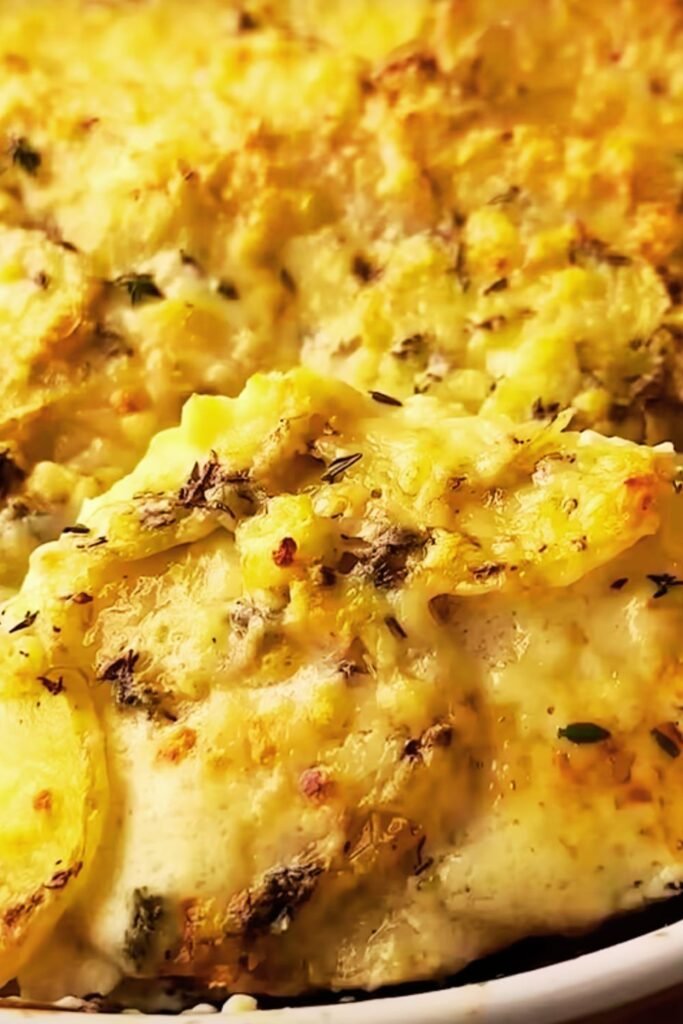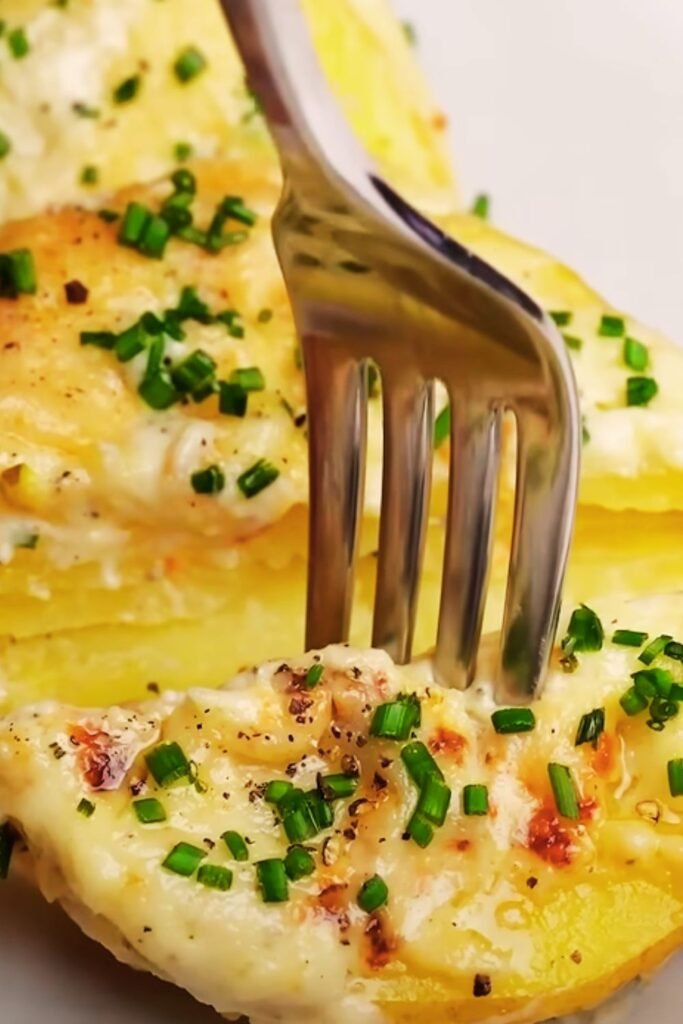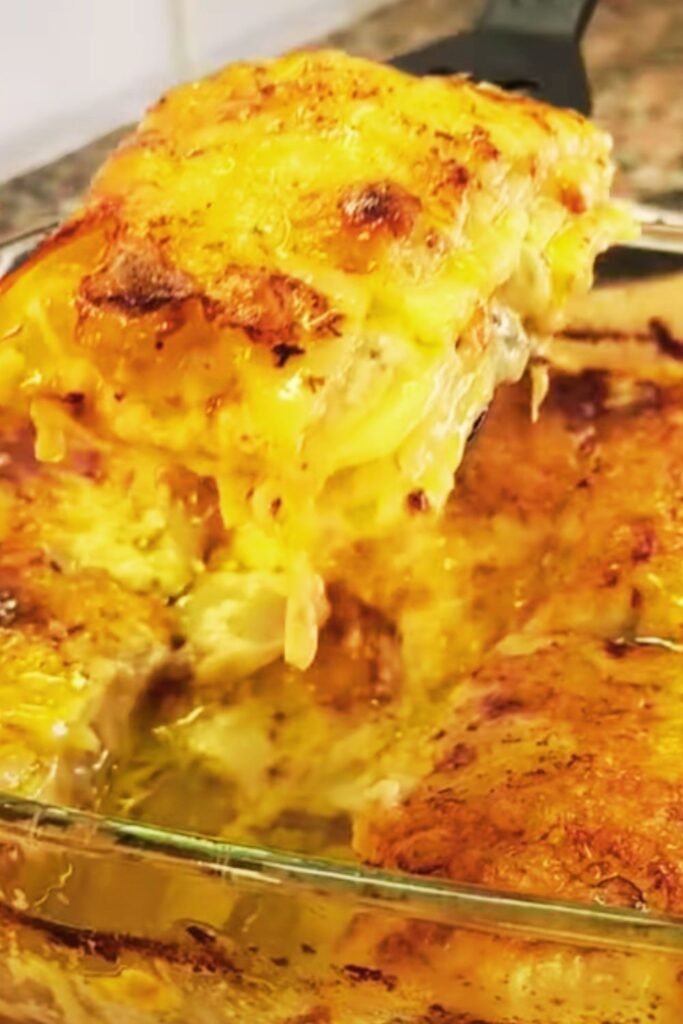I’ve been obsessed with Ruth’s Chris Steak House’s legendary potatoes au gratin for years. There’s something absolutely magical about those golden, bubbly layers of tender potatoes swimming in rich, creamy sauce that makes my mouth water every single time. After countless attempts and kitchen experiments, I finally cracked the code to recreate this restaurant masterpiece at home.
Let me share with you the secrets I’ve discovered to make these incredible potatoes that taste just like the ones from Ruth’s Chris. Trust me, once you master this recipe, you’ll never want to order takeout again.
What Makes Ruth’s Chris Potatoes So Special?
Ruth’s Chris has built their reputation on serving the finest steaks, but their sides are equally impressive. Their potatoes au gratin stands out because of three key elements that I’ve identified through my research and taste testing:
Premium Ingredients: They use only the highest quality potatoes, typically Yukon Gold or Russet varieties, combined with real heavy cream and aged cheeses. No shortcuts or substitutions here.
Perfect Technique: The potatoes are sliced to precise thickness, layered methodically, and baked at specific temperatures that create that perfect balance of creamy interior and golden top.
Signature Seasoning Blend: There’s a particular combination of herbs and spices that gives these potatoes their distinctive flavor profile that keeps customers coming back.
Essential Ingredients for Perfect Copycat Potatoes
Creating restaurant-quality potatoes au gratin requires careful attention to ingredient selection. Here’s what I’ve learned works best:
Primary Ingredients
| Ingredient | Amount | Quality Notes |
|---|---|---|
| Yukon Gold Potatoes | 3 lbs | Choose firm, unblemished potatoes |
| Heavy Cream | 2 cups | Must be at least 35% fat content |
| Whole Milk | 1 cup | Full-fat only, no substitutes |
| Gruyere Cheese | 8 oz | Freshly grated, aged variety |
| Sharp Cheddar | 6 oz | White cheddar preferred |
| Parmesan Cheese | 4 oz | Freshly grated Parmigiano-Reggiano |
| Unsalted Butter | 4 tablespoons | European-style for richness |
| All-Purpose Flour | 3 tablespoons | For thickening base |
Seasoning Components
| Seasoning | Amount | Purpose |
|---|---|---|
| Kosher Salt | 2 teaspoons | Enhances all flavors |
| White Pepper | 1/2 teaspoon | Subtle heat without color |
| Garlic Powder | 1/2 teaspoon | Aromatic depth |
| Onion Powder | 1/4 teaspoon | Savory complexity |
| Fresh Thyme | 1 tablespoon | Herbal brightness |
| Nutmeg | 1/8 teaspoon | Warm spice note |

Step-by-Step Preparation Method
My perfected technique ensures every layer of potato is perfectly cooked and the sauce penetrates throughout. Here’s my proven method:
Preparation Phase
First, I preheat my oven to 375°F (190°C). This temperature is crucial for achieving that perfect golden top while ensuring the potatoes cook evenly throughout.
I start by washing and peeling the potatoes thoroughly. The key is slicing them to exactly 1/8-inch thickness. I use a mandoline slicer for consistency, but a sharp knife works if you’re careful about uniform thickness.
Creating the Cream Base
In a large, heavy-bottomed saucepan, I melt the butter over medium heat. Once it’s completely melted and slightly foaming, I whisk in the flour to create a roux. This step is essential for preventing lumps in the final sauce.
I cook the roux for about 2 minutes, whisking constantly, until it becomes fragrant and loses its raw flour taste. Then I gradually add the heavy cream and milk, whisking continuously to prevent lumps from forming.
Seasoning the Mixture
Once the cream mixture is smooth, I add the kosher salt, white pepper, garlic powder, onion powder, and nutmeg. I let this simmer gently for 5-7 minutes until it thickens slightly and coats the back of a spoon.
The mixture should have the consistency of heavy cream but with more body. If it gets too thick, I add a little more milk. If it’s too thin, I simmer it longer.
Layering Technique
I butter a 9×13-inch baking dish generously. Then I arrange one-third of the sliced potatoes in an overlapping pattern, like shingles on a roof. I season this layer lightly with salt and pepper.
I pour one-third of the cream mixture over the potatoes, making sure it seeps between the layers. Then I sprinkle one-third of the mixed cheeses over the cream.
I repeat this process two more times, ending with cheese on top. The final layer should have the most generous amount of cheese for that beautiful golden crust.

Baking Instructions for Perfect Results
The baking process is where the magic happens. I cover the dish with aluminum foil and bake for 45 minutes. This initial covered period allows the potatoes to steam and become tender.
After 45 minutes, I remove the foil and continue baking for another 25-30 minutes until the top is golden brown and bubbly. The internal temperature should reach 165°F (74°C) when measured with a food thermometer.
During the last 10 minutes of baking, I sprinkle the fresh thyme over the top. This adds a beautiful aromatic element that really elevates the dish.
Cheese Selection and Combinations
The cheese blend is absolutely critical to achieving that authentic Ruth’s Chris flavor. Through my experiments, I’ve found that the combination of Gruyere, sharp cheddar, and Parmesan creates the perfect flavor profile.
Gruyere: This Swiss cheese provides nutty, complex flavors and excellent melting properties. It’s the star of the show and shouldn’t be substituted.
Sharp Cheddar: White cheddar adds sharpness and helps create that classic au gratin flavor. I always use freshly grated cheese rather than pre-shredded.
Parmesan: The aged Parmigiano-Reggiano adds umami depth and helps create the golden crust on top.
Cheese Preparation Tips
| Cheese Type | Grating Method | Storage Tips |
|---|---|---|
| Gruyere | Medium holes on box grater | Wrap in parchment, then plastic |
| Sharp Cheddar | Large holes on box grater | Store in cheese paper |
| Parmesan | Microplane or fine grater | Keep in airtight container |
Troubleshooting Common Issues
Over my years of perfecting this recipe, I’ve encountered and solved numerous problems. Here are the most common issues and my solutions:
Watery Potatoes
This usually happens when the potatoes release too much moisture during baking. To prevent this, I always pat the sliced potatoes dry with paper towels before layering. I also make sure not to overcrowd the layers.
Broken Cream Sauce
If the cream sauce separates or curdles, it’s typically because the heat was too high or the cream was added too quickly. I always keep the heat at medium or lower and add the cream gradually while whisking constantly.
Uneven Cooking
Some potatoes remain hard while others are mushy. This is usually due to inconsistent slicing. Using a mandoline slicer ensures uniform thickness, which is crucial for even cooking.
Burnt Top
If the cheese on top browns too quickly, I cover it with foil for the remainder of the baking time. The key is finding the right balance between golden browning and preventing burning.

Serving Suggestions and Pairings
These potatoes are incredibly versatile and pair beautifully with many main dishes. At Ruth’s Chris, they’re typically served alongside their famous steaks, but I’ve found they complement many other proteins perfectly.
Ideal Main Course Pairings
Grilled Steaks: The classic pairing. The rich, creamy potatoes balance the bold flavors of a perfectly grilled ribeye or filet mignon.
Roasted Chicken: The herbs in the potatoes complement roasted chicken beautifully, especially when the chicken is seasoned with rosemary and thyme.
Pork Tenderloin: The creamy texture and cheese flavors work wonderfully with seasoned pork tenderloin or pork chops.
Lamb Chops: The richness of the potatoes pairs excellently with herb-crusted lamb chops or leg of lamb.
Vegetable Accompaniments
I always serve these potatoes with lighter vegetable sides to balance the richness. Some of my favorites include:
- Steamed asparagus with lemon
- Roasted Brussels sprouts with bacon
- Fresh green salad with vinaigrette
- Grilled zucchini and bell peppers
Storage and Reheating Instructions
These potatoes actually taste even better the next day as the flavors have time to meld together. Here’s how I handle storage and reheating:
Storage Guidelines
| Storage Method | Duration | Temperature |
|---|---|---|
| Refrigerator | 3-4 days | 35-40°F |
| Freezer | 2-3 months | 0°F |
| Room Temperature | 2 hours maximum | Below 70°F |
Reheating Techniques
For best results, I reheat portions in a 350°F oven for 15-20 minutes until heated through. I cover with foil to prevent the top from over-browning.
Microwave reheating works in a pinch, but the texture won’t be quite as good. I use 50% power and heat in 1-minute intervals, stirring between each interval.
Make-Ahead Tips and Variations
One of the things I love about this recipe is how well it can be prepared in advance. Here are my strategies for make-ahead success:
Advance Preparation Options
Day Before: I can assemble the entire dish up to the point of baking, cover tightly, and refrigerate overnight. I just need to add about 10-15 minutes to the baking time if starting from cold.
Partial Prep: I can slice the potatoes and store them in water (to prevent browning) up to 6 hours ahead. I can also prepare the cream sauce earlier in the day and reheat it gently before assembling.
Delicious Variations
Herb-Crusted Version: I sometimes add a mixture of panko breadcrumbs, fresh herbs, and melted butter on top during the last 15 minutes of baking for extra texture.
Bacon Addition: For special occasions, I layer in crispy bacon pieces between the potato layers for a smoky flavor boost.
Lighter Version: I can substitute half the heavy cream with whole milk and use a mix of regular and reduced-fat cheeses to lighten the dish slightly.
Nutritional Information and Dietary Considerations
While these potatoes are definitely an indulgent side dish, understanding their nutritional profile helps with meal planning:
Nutritional Breakdown (Per Serving)
| Nutrient | Amount | % Daily Value |
|---|---|---|
| Calories | 385 | 19% |
| Total Fat | 28g | 43% |
| Saturated Fat | 17g | 85% |
| Cholesterol | 85mg | 28% |
| Sodium | 520mg | 23% |
| Carbohydrates | 22g | 8% |
| Protein | 12g | 24% |
| Calcium | 425mg | 42% |
Dietary Modifications
For those with dietary restrictions, I’ve experimented with several modifications:
Gluten-Free: I substitute the flour with cornstarch or gluten-free flour blend. The texture is slightly different but still delicious.
Dairy-Free: This is challenging since dairy is central to the dish, but I’ve had some success using cashew cream and nutritional yeast, though the flavor profile changes significantly.
Lower Fat: I can use half-and-half instead of heavy cream and reduce the cheese quantities, though the result is less rich.
Professional Tips for Restaurant-Quality Results
After perfecting this recipe, I’ve learned several professional techniques that make a significant difference:
Equipment Recommendations
Mandoline Slicer: This is my number one recommendation for achieving uniform potato slices. The consistency is crucial for even cooking.
Heavy-Bottomed Saucepan: Essential for preventing the cream sauce from scorching. I prefer stainless steel or enameled cast iron.
Digital Thermometer: Helps ensure the internal temperature reaches 165°F for food safety and optimal texture.
Timing Strategies
I always start this dish early since it takes about 1 hour and 15 minutes from start to finish. The resting time after baking is also important – I let it sit for 10-15 minutes before serving to allow the layers to set.
Questions and Answers
Q: Can I use different types of potatoes for this recipe? A: While Yukon Gold potatoes are my preferred choice because of their creamy texture and ability to hold their shape, you can use Russet potatoes for a more traditional approach. Red potatoes tend to be too waxy and don’t absorb the cream as well, so I don’t recommend them for this specific recipe.
Q: Why do my potatoes turn out watery even when I follow the recipe exactly? A: This usually happens because the potatoes weren’t dried properly after slicing, or the cream sauce wasn’t thick enough before assembling. Make sure to pat the potato slices completely dry with paper towels and ensure your cream sauce coats the back of a spoon before layering.
Q: Can I make this recipe in individual portions? A: Absolutely! I often make these in individual ramekins for dinner parties. Use 6-8 ramekins and reduce the baking time to about 35-40 minutes total. The presentation is beautiful and makes serving much easier.
Q: What’s the best way to slice potatoes if I don’t have a mandoline? A: Use your sharpest knife and take your time to ensure even slices. I aim for about 1/8-inch thickness – roughly the thickness of a quarter coin. Consistent thickness is more important than perfect thinness.
Q: Can I freeze the assembled dish before baking? A: Yes, you can freeze the assembled dish for up to 3 months. Wrap it tightly in plastic wrap and aluminum foil. When ready to bake, thaw completely in the refrigerator overnight, then bake as directed, adding about 10-15 minutes to the cooking time.
Q: Why does my cheese sauce sometimes become grainy? A: Grainy cheese sauce usually results from overheating or adding the cheese too quickly. Always add cheese off the heat and stir gently until melted. If it does become grainy, you can sometimes save it by whisking in a tablespoon of cold cream.
Q: How do I know when the potatoes are perfectly done? A: The top should be golden brown and bubbly, and when you insert a knife into the center, it should go through easily without resistance. The internal temperature should reach 165°F. The edges might be slightly darker, which is perfectly normal.
Q: Can I add other vegetables to this recipe? A: While traditional au gratin is just potatoes, I’ve successfully added thin slices of onion between the layers, or sometimes a layer of roasted garlic. Keep additions minimal so they don’t compete with the classic flavors.
Q: What’s the secret to getting the perfect golden top? A: The key is using freshly grated cheese (pre-shredded doesn’t brown as well) and making sure the final layer has a generous amount of cheese. If needed, I sometimes switch to broil for the last 2-3 minutes, watching carefully to prevent burning.
Q: How far in advance can I prepare this dish? A: You can slice the potatoes and store them in cold water up to 6 hours ahead. The cream sauce can be made earlier in the day and reheated gently. The fully assembled dish can be refrigerated overnight before baking, though you’ll need to add extra baking time.
This copycat recipe has become one of my signature dishes, and I’m confident it will become a favorite in your kitchen too. The combination of perfectly seasoned potatoes, rich cream sauce, and golden cheese creates a side dish that’s worthy of any special occasion or Sunday dinner. The technique might seem involved, but once you master it, you’ll find yourself making these potatoes regularly – they’re just that good.